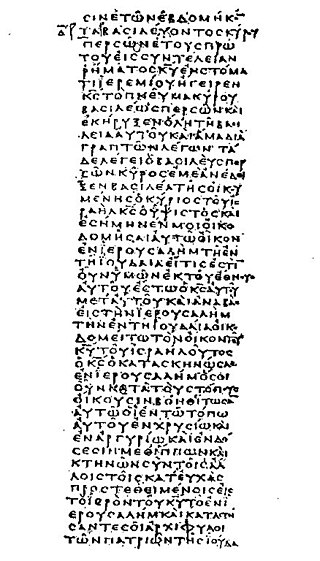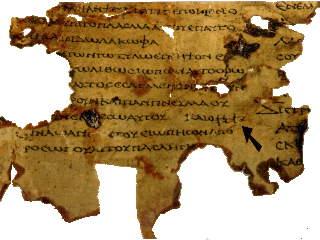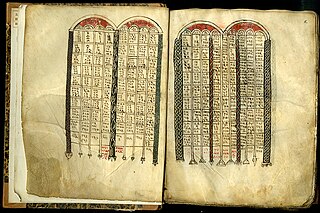
The Septuagint, sometimes referred to as the Greek Old Testament or The Translation of the Seventy, and abbreviated as LXX, is the earliest extant Greek translation of the Hebrew Bible from the original Biblical Hebrew. The full Greek title derives from the story recorded in the Letter of Aristeas to Philocrates that "the laws of the Jews" were translated into the Greek language at the request of Ptolemy II Philadelphus by seventy-two Hebrew translators—six from each of the Twelve Tribes of Israel.

Papyrus 46, designated by siglum 𝔓46, is an early Greek New Testament manuscript written on papyrus, and is one of the manuscripts comprising the Chester Beatty Papyri. Manuscripts among the Chester Beatty Papyri have had several provenances associated with them, the most likely being the Faiyum. It has been paleographically dated between 175 and 225, or early 3rd century CE. It contains verses from the Pauline Epistles of Romans, 1 Corinthians, 2 Corinthians, Galatians, Ephesians, Colossians, Philippians, 1 Thessalonians, and Hebrews. Some leaves are part of the Chester Beatty Biblical Papyri, and others are in the University of Michigan Papyrus Collection.

The Cotton Genesis is a 4th- or 5th-century Greek Illuminated manuscript copy of the Book of Genesis. It was a luxury manuscript with many miniatures. It is one of the oldest illustrated biblical codices to survive to the modern period. Most of the manuscript was destroyed in the Cotton library fire in 1731, leaving only eighteen charred, shrunken scraps of vellum. From the remnants, the manuscript appears to have been more than 440 pages with approximately 340–360 illustrations that were framed and inserted into the text column. Many miniatures were also copied in the 17th century and are now in the Bibliothèque nationale de France in Paris.

In Christian scribal practice, nomina sacra is the abbreviation of several frequently occurring divine names or titles, especially in Greek manuscripts of the Bible. A nomen sacrum consists of two or more letters from the original word spanned by an overline.

The earliest surviving manuscripts of the Septuagint, an ancient translation of the ancient Hebrew Torah into Koine Greek, include three 2nd century BCE fragments from the books of Leviticus and Deuteronomy and five 1st century BCE fragments of Genesis, Exodus, Leviticus, Numbers, and Deuteronomy, only. The vast majority of Septuagint manuscripts are late-antiquity and medieval manuscript versions of the Christian Greek Old Testament tradition.

Codex Tischendorfianus III – designated by siglum Λ or 039, ε 77 – is a Greek uncial manuscript of the Gospels on parchment. Palaeographically it has been assigned to the 9th or 10th century.
The Biblical Manuscripts in the Freer Collection, a collection of nine biblical manuscripts, date from the 3rd to 6th centuries. Most of the manuscripts are written in Greek, four in Coptic. They are important witnesses of the history of the text of New Testament and Septuagint. The collection was established by Charles Freer (1854–1919), an industrialist from Detroit, Michigan and is held at the Freer Gallery of Art in Washington D.C.

Minuscule 700, ε 133, is a Greek New Testament minuscule manuscript of the Gospels, written on parchment. It was formerly labelled as 604 in all New Testament manuscript lists, however textual critic Caspar René Gregory gave it the number 700. Using the study of comparative writing styles (palaeography), it has been dated to the 11th century. It is currently housed at the British Library in London.
Papyrus 62, also known as ‘‘Papyrus Osloensis’’, is a copy of the New Testament and Septuagint in Greek and Coptic known as a diglot. It is designated by the siglum 𝔓62 in the Gregory-Aland numbering of New Testament manuscripts. It is a papyrus manuscript of the Gospel of Matthew and Book of Daniel in a fragmentary condition. Using the study of comparative writing styles (palaeography), it has been assigned to the 4th century CE.

Lectionary 2137, designated by ℓ2137 in the Gregory-Aland numbering. It is a Greek manuscript of the New Testament, on parchment leaves, dated paleographically to the 12th century.
Minuscule 2757, is a Greek minuscule manuscript of the New Testament, written on 266 parchment leaves. Palaeographically it has been assigned to the 12th century.

Minuscule 57, δ 255, Rahlfs number 69, is a Greek minuscule manuscript of the New Testament and the Psalms, written on parchment. Using the study of comparative writing styles (palaeography), it has been assigned to the 12th century. The manuscript is lacunose. It has marginalia.
Lectionary 245, designated by siglum ℓ245 is a Greek manuscript of the New Testament, on parchment. Palaeographically it has been assigned to the 9th century. The manuscript has survived on only two leaves.

Papyrus 967 is a 3rd-century CE biblical manuscript, discovered in 1931. It is notable for containing fragments of the original Septuagint text of the Book of Daniel, which was completely superseded by a revised text by the end of the 4th century and elsewhere survives only in Syriac translation and in Codex Chisianus 88. The manuscript is also important for early variants, both in the text of the Book of Ezekiel and of the Book of Daniel.

Papyrus Oxyrhynchus 1007 is a fragment of a Greek Septuagint manuscript written on parchment. The manuscript was discovered in Oxyrhynchus, modern El-Bahnasa, Egypt. Using the study of comparative writing styles (palaeography), the manuscript has been dated to the 3rd century CE.

The ms. Ambrosiano O 39 sup. – is a manuscript of the Hexapla of Origen dated to the late ninth century C.E. written in a codex form. This is a palimpsest, meaning that the current text is written on leaves which had been written on before and cleaned.

The siglum Taylor-Schechter 12.182 designates a manuscript written on parchment in codex form. This is a palimpsest of a copy of Origen's work called the Hexapla. The manuscript is dated to 7th-century AD, and is the oldest of the hexapla manuscripts. The hexapla was completed before 240 AD.
P. Lond.Lit.207 is a Greek fragment of a Septuagint manuscript written on papyrus in codex form. This manuscript discovered at Fayum, contains parts of the Book of Psalms. Palaeographycally it is dated to late third century or early fourth century.

The Papyrus Chester Beatty VI are fragments of a papyrus manuscript of the Greek Septuagint and one of the Chester Beatty papyri. It contains parts of the Book of Numbers and Deuteronomy. Using the study of comparative writing styles (palaeography), it has been dated to 200 CE.
The Papyrus Chester Beatty VIII is a fragment of a septuagint manuscript that contains parts of the biblical Book of Jeremiah. Palaeographically it has been dated to the late second, early third century CE.














